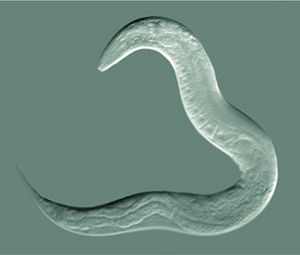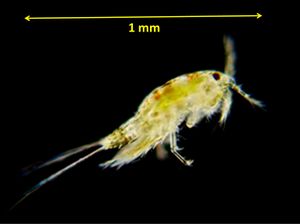Meiofauna
Definition of meiofauna:
Meiofauna or meiobenthos are small benthic invertebrates that live in both marine and fresh water environments. The term meiofauna loosely defines a group of organisms by their size, larger than microfauna but smaller than macrofauna, rather than a taxonomic grouping. In practice these are organisms that can pass through a 1 mm mesh but will be retained by a 45 μm mesh, but the exact dimensions will vary from researcher to researcher. Whether an organism will pass through a 1 mm mesh will also depend upon whether it is alive or dead at the time of sorting.[1]
This is the common definition for meiofauna, other definitions can be discussed in the article
|
Contents
Influence on sediment properties

Meiofauna, which represents the most abundant group of animals in the ocean, is dominated by nematodes and copepods (generally more than 80% abundance). Other meiofauna taxa include ostracods, bivalves, kinorhynchs, gastropods, arachnids, tardigrades, tanaidaceans, turbellarians, insects, oligochaetes, gastrotrichs, sipunculids, cumaceans, isopods, cnidarians, and holothurians. Meiofauna biomass is concentrated in the top few centimeters of the marine seabed[2].
Meiofauna build and maintain burrows that act as vertical conveyors within sediments
and between the sediments and overlying water, thereby modifying hydrodynamics in sediments and affecting nutrient cycling and biogeochemical fluxes, and changing vertical chemical gradients in the sediment[3]. As they move through the sediment, meiofauna secrete trails of mucus and stimulate growth of bacteria, which helps stabilize the sediment grains, holding them together and impeding erosion by tides and waves. Nematodes in particular produce sticky mucus which serves for attaching eggs to the sediment and for stabilizing burrows.
Role in the food web
Harpacticoid copepods contain fatty acids with a high nutritional value. They are therefore the favorite food for epibenthic predators, such as juvenile bottom-feeding fish (e.g., flatfish, gobies, and mullets).[4] For adult demersal fish, meiofauna is too small to meet the nutritional requirements. There is generally no strong predatory pressure on the highly abundant meiofaunal populations. Moreover, the short life cycle of meiofauna always allows for rapid replenishment of the population[5].
Meiofauna consume a wide spectrum of food sources, including microalgae, protozoans, small metazoans, bacteria and organic detritus. However, there is evidence that meiofauna only play a marginal role in carbon cycling with ingestion rates < 5% of total heterotrophic ingestion in the benthic ecosystem[5]. Meiofauna are a direct link between primary production and higher trophic levels when they feed on microalgae; there is an indirect link when meiofauna feed on secretions of primary producers (e.g., extracellular polymeric substances), decaying organic matter and/or associated microbiota.
Organic matter mineralization
Nematodes do not decompose organic matter, but, instead, are parasitic and free-living organisms that feed on living material[6]. As meiofauna feed, they remove microbes, diatoms and other protozoans from the sediment. Meiofauna are capable of eating their bodyweight equivalent in microorganisms each day. Grazing of meiofauna on microbiota promotes organic matter mineralization and nutrient cycling by keeping the microbial community in an active growth phase. Microbes decompose organic matter to satisfy the nitrogen demand for their growth. The excretions and secretions (mucus) of nematodes are particularly rich in nitrogen, which is available for the microbial community and stimulates their activity and growth[7].
The construction of burrows by meiofauna enhances nutrient and oxygen fluxes and thus stimulates aerobic degradation of organic matter. This significantly increases the effective area of the sediment-water interface, enhances aerobic zones in the sediment and stimulates the aerobic microbial community[8].
Sediment decontamination
Meiofauna play a role in counteracting or promoting removal of pollutants from contaminated sediments. A microcosm experiment with sediment contaminated with polycyclic aromatic hydrocarbons (PAH) showed inhibition of PAH-degrading bacteria when meiofauna was introduced, likely due to grazing and/or competition for nutrients[9]. In contrast, other experiments have shown that nematodes possess metal-binding proteins capable to bind heavy metals. These metals subsequently accumulate within nematode tissues and are thus removed from the sediment[10].
Related articles
References
- ↑ http://en.wikipedia.org/wiki/Meiobenthos
- ↑ Reuscher, M.G., Montagna, P.A., Sturdivant, S.K. 2019. Sampling Techniques for the Marine Benthos. In Encyclopedia of Ocean Sciences (3rd edition, editors: J. Kirk Cochran, Henry J. Bokuniewicz, Patricia L. Yager), Elsevier
- ↑ Coull, B.C. 1999. Role of meiofauna in estuarine soft-bottom habitats. Aust. J. Ecol. 24: 327–343
- ↑ Coull, B.C. 1990. Are Members of the Meiofauna Food for Higher Trophic Levels? Transactions of the American Microscopical Society 109: 233-246
- ↑ 5.0 5.1 Schratzberger, M. and Ingels, J. 2018. Meiofauna matters: The roles of meiofauna in benthic ecosystems. Journal of Experimental Marine Biology and Ecology 502: 12–25
- ↑ Heip, C., Vincx, M. and Vranken, G. 1985. The ecology of marine nematodes. Oceanogr. Mar. Biol. Annu. Rev. 23: 399–489
- ↑ Heip, C.H.R. and Herman, P.M.J. 1985. The stability of a benthic copepod community. In Gibbs, P.E. (Ed.), Proceedings of the 19th European Marine Biology Symposium, Plymouth, Devon, pp. 255-263
- ↑ Middelburg, J.J. and Levin, L.A. 2009. Coastal hypoxia and sediment biogeochemistry. Biogeosciences Discuss. 6: 3655–3706
- ↑ Louati, H., Said, O.B., Soltani, A., Got, P., Mahmoudi, E., Cravo-Laureau, C., Duran, R., Aissa, P. and Pringault, O. 2013. The roles of biological interactions and pollutant contamination in shaping microbial benthic community structure. Chemosphere 93: 2535–2546
- ↑ Monserrat, J.M., Rosa, C.E., Sandrini, J.Z., Marins, L.F., Bianchini, A. and Geracitano, L.A. 2003. Annelids and nematodes as sentinels of environmental pollution. Comments Toxicol. 9,:289–301
Please note that others may also have edited the contents of this article.
|
